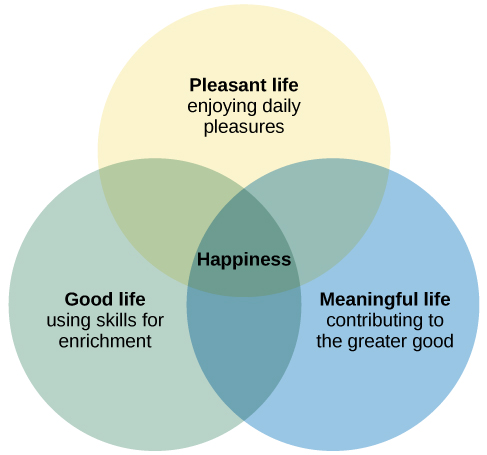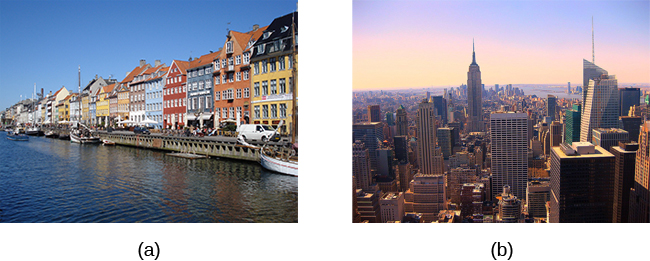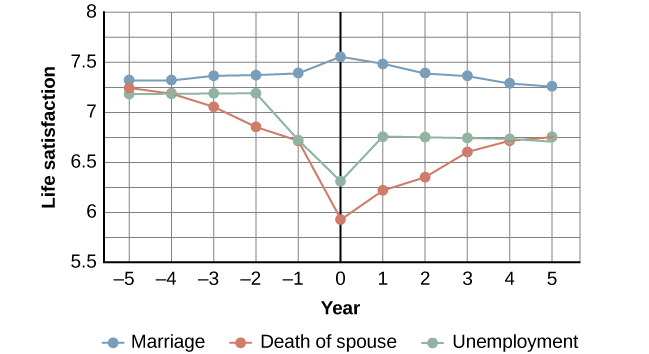125 The Pursuit of Happiness
Learning Objectives
By the end of this section, you will be able to:
- Define and discuss happiness, including its determinants
- Describe the field of positive psychology and identify the kinds of problems it addresses
- Explain the meaning of positive affect and discuss its importance in health outcomes
- Describe the concept of flow and its relationship to happiness and fulfillment
Although the study of stress and how it affects us physically and psychologically is fascinating, it is—admittedly—somewhat of a grim topic. Psychology is also interested in the study of a more upbeat and encouraging approach to human affairs—the quest for happiness.
Happiness
America’s founders declared that its citizens have an unalienable right to pursue happiness. But what is happiness? When asked to define the term, people emphasize different aspects of this elusive state. Indeed, happiness is somewhat ambiguous and can be defined from different perspectives (Martin, 2012). Some people, especially those who are highly committed to their religious faith, view happiness in ways that emphasize virtuosity, reverence, and enlightened spirituality. Others see happiness as primarily contentment—the inner peace and joy that come from deep satisfaction with one’s surroundings, relationships with others, accomplishments, and oneself. Still others view happiness mainly as pleasurable engagement with their personal environment—having a career and hobbies that are engaging, meaningful, rewarding, and exciting. These differences, of course, are merely differences in emphasis. Most people would probably agree that each of these views, in some respects, captures the essence of happiness.
Elements of Happiness
Some psychologists have suggested that happiness consists of three distinct elements: the pleasant life, the good life, and the meaningful life, as shown in Figure SH.23 (Seligman, 2002; Seligman, Steen, Park, & Peterson, 2005). The pleasant life is realized through the attainment of day-to-day pleasures that add fun, joy, and excitement to our lives. For example, evening walks along the beach and a fulfilling sex life can enhance our daily pleasure and contribute to the pleasant life. The good life is achieved through identifying our unique skills and abilities and engaging these talents to enrich our lives; those who achieve the good life often find themselves absorbed in their work or their recreational pursuits. The meaningful life involves a deep sense of fulfillment that comes from using our talents in the service of the greater good: in ways that benefit the lives of others or that make the world a better place. In general, the happiest people tend to be those who pursue the full life—they orient their pursuits toward all three elements (Seligman et al., 2005).

For practical purposes, a precise definition of happiness might incorporate each of these elements: an enduring state of mind consisting of joy, contentment, and other positive emotions, plus the sense that one’s life has meaning and value (Lyubomirsky, 2001). The definition implies that happiness is a long-term state—what is often characterized as subjective well-being—rather than merely a transient positive mood we all experience from time to time. It is this enduring happiness that has captured the interests of psychologists and other social scientists.
The study of happiness has grown dramatically in the last three decades (Diener, 2013). One of the most basic questions that happiness investigators routinely examine is this: How happy are people in general? The average person in the world tends to be relatively happy and tends to indicate experiencing more positive feelings than negative feelings (Diener, Ng, Harter, & Arora, 2010). When asked to evaluate their current lives on a scale ranging from 0 to 10 (with 0 representing “worst possible life” and 10 representing “best possible life”), people in more than 150 countries surveyed from 2010–2012 reported an average score of 5.2. People who live in North America, Australia, and New Zealand reported the highest average score at 7.1, whereas those living Sub-Saharan Africa reported the lowest average score at 4.6 (Helliwell, Layard, & Sachs, 2013). Worldwide, the five happiest countries are Denmark, Norway, Switzerland, the Netherlands, and Sweden; the United States is ranked 17th happiest (Figure SH.24) (Helliwell et al., 2013).

Several years ago, a Gallup survey of more than 1,000 U.S. adults found that 52% reported that they were “very happy.” In addition, more than 8 in 10 indicated that they were “very satisfied” with their lives (Carroll, 2007). However, a recent poll found that only 42% of American adults report being “very happy.” The groups that show the greatest declines in happiness are people of colour, those who have not completed a college education, and those who politically identify as Democrats or independents (McCarthy, 2020). These results suggest that challenging economic conditions may be related to declines in happiness. Of course, this interpretation implies that happiness is closely tied to one’s finances. But, is it? What factors influence happiness?
Factors Connected to Happiness
What really makes people happy? What factors contribute to sustained joy and contentment? Is it money, attractiveness, material possessions, a rewarding occupation, a satisfying relationship? Extensive research over the years has examined this question. One finding is that age is related to happiness: Life satisfaction usually increases the older people get, but there do not appear to be gender differences in happiness (Diener, Suh, Lucas, & Smith, 1999). Although it is important to point out that much of this work has been correlational, many of the key findings (some of which may surprise you) are summarized below.
Family and other social relationships appear to be key factors correlated with happiness. Studies show that married people report being happier than those who are single, divorced, or widowed (Diener et al., 1999). Happy individuals also report that their marriages are fulfilling (Lyubomirsky, King, & Diener, 2005). In fact, some have suggested that satisfaction with marriage and family life is the strongest predictor of happiness (Myers, 2000). Happy people tend to have more friends, more high-quality social relationships, and stronger social support networks than less happy people (Lyubomirsky et al., 2005). Happy people also have a high frequency of contact with friends (Pinquart & Sörensen, 2000).
Can money buy happiness? In general, extensive research suggests that the answer is yes, but with several caveats. While a nation’s per capita gross domestic product (GDP) is associated with happiness levels (Helliwell et al., 2013), changes in GDP (which is a less certain index of household income) bear little relationship to changes in happiness (Diener, Tay, & Oishi, 2013). On the whole, residents of affluent countries tend to be happier than residents of poor countries; within countries, wealthy individuals are happier than poor individuals, but the association is much weaker (Diener & Biswas-Diener, 2002). To the extent that it leads to increases in purchasing power, increases in income are associated with increases in happiness (Diener, Oishi, & Ryan, 2013). However, income within societies appears to correlate with happiness only up to a point. In a study of over 450,000 U.S. residents surveyed by the Gallup Organization, Kahneman and Deaton (2010) found that well-being rises with annual income, but only up to $75,000. The average increase in reported well-being for people with incomes greater than $75,000 was null. As implausible as these findings might seem—after all, higher incomes would enable people to indulge in Hawaiian vacations, prime seats as sporting events, expensive automobiles, and expansive new homes—higher incomes may impair people’s ability to savour and enjoy the small pleasures of life (Kahneman, 2011). Indeed, researchers in one study found that participants exposed to a subliminal reminder of wealth spent less time savouring a chocolate candy bar and exhibited less enjoyment of this experience than did participants who were not reminded of wealth (Quoidbach, Dunn, Petrides, & Mikolajczak, 2010).
What about education and employment? Happy people, compared to those who are less happy, are more likely to graduate from college and secure more meaningful and engaging jobs. Once they obtain a job, they are also more likely to succeed (Lyubomirsky et al., 2005). While education shows a positive (but weak) correlation with happiness, intelligence is not appreciably related to happiness (Diener et al., 1999).
Does religiosity correlate with happiness? In general, the answer is yes (Hackney & Sanders, 2003). However, the relationship between religiosity and happiness depends on societal circumstances. Nations and states with more difficult living conditions (e.g., widespread hunger and low life expectancy) tend to be more highly religious than societies with more favourable living conditions. Among those who live in nations with difficult living conditions, religiosity is associated with greater well-being; in nations with more favourable living conditions, religious and nonreligious individuals report similar levels of well-being (Diener, Tay, & Myers, 2011).
Clearly the living conditions of one’s nation can influence factors related to happiness. What about the influence of one’s culture? To the extent that people possess characteristics that are highly valued by their culture, they tend to be happier (Diener, 2012). For example, self-esteem is a stronger predictor of life satisfaction in individualistic cultures than in collectivistic cultures (Diener, Diener, & Diener, 1995), and extraverted people tend to be happier in extraverted cultures than in introverted cultures (Fulmer et al., 2010).
So we’ve identified many factors that exhibit some correlation to happiness. What factors don’t show a correlation? Researchers have studied both parenthood and physical attractiveness as potential contributors to happiness, but no link has been identified. Although people tend to believe that parenthood is central to a meaningful and fulfilling life, aggregate findings from a range of countries indicate that people who do not have children are generally happier than those who do (Hansen, 2012). And although one’s perceived level of attractiveness seems to predict happiness, a person’s objective physical attractiveness is only weakly correlated with their happiness (Diener, Wolsic, & Fujita, 1995).
Life Events and Happiness
An important point should be considered regarding happiness. People are often poor at affective forecasting: predicting the intensity and duration of their future emotions (Wilson & Gilbert, 2003). In one study, nearly all newlywed spouses predicted their marital satisfaction would remain stable or improve over the following four years; despite this high level of initial optimism, their marital satisfaction actually declined during this period (Lavner, Karner, & Bradbury, 2013). In addition, we are often incorrect when estimating how our long-term happiness would change for the better or worse in response to certain life events. For example, it is easy for many of us to imagine how euphoric we would feel if we won the lottery, were asked on a date by an attractive celebrity, or were offered our dream job. It is also easy to understand how long-suffering fans of the Chicago Cubs baseball team, which had not won a World Series championship since 1908, thought they would feel permanently elated when their team finally won another World Series in 2016. Likewise, it is easy to predict that we would feel permanently miserable if we suffered a disabling accident or if a romantic relationship ended.
However, something similar to sensory adaptation often occurs when people experience emotional reactions to life events. In much the same way our senses adapt to changes in stimulation (e.g., our eyes adapting to bright light after walking out of the darkness of a movie theatre into the bright afternoon sun), we eventually adapt to changing emotional circumstances in our lives (Brickman & Campbell, 1971; Helson, 1964). When an event that provokes positive or negative emotions occurs, at first we tend to experience its emotional impact at full intensity. We feel a burst of pleasure following such things as a marriage proposal, birth of a child, acceptance to law school, an inheritance, and the like; as you might imagine, lottery winners experience a surge of happiness after hitting the jackpot (Lutter, 2007). Likewise, we experience a surge of misery following the death of a loved one, a divorce, or a layoff from work. In the long run, however, we eventually adjust to the emotional new normal; the emotional impact of the event tends to erode, and we eventually revert to our original baseline happiness levels. Thus, what was at first a thrilling lottery windfall or World Series championship eventually loses its lustre and becomes the status quo (Figure SH.25). Indeed, dramatic life events have much less long-lasting impact on happiness than might be expected (Brickman, Coats, & Janoff-Bulman, 1978).

Recently, some have raised questions concerning the extent to which important life events can permanently alter people’s happiness set points (Diener, Lucas, & Scollon, 2006). Evidence from a number of investigations suggests that, in some circumstances, happiness levels do not revert to their original positions. For example, although people generally tend to adapt to marriage so that it no longer makes them happier or unhappier than before, they often do not fully adapt to unemployment or severe disabilities (Diener, 2012). Figure SH.26, which is based on longitudinal data from a sample of over 3,000 German respondents, shows life satisfaction scores several years before, during, and after various life events, and it illustrates how people adapt (or fail to adapt) to these events. German respondents did not get lasting emotional boosts from marriage; instead, they reported brief increases in happiness, followed by quick adaptation. In contrast, widows and those who had been laid off experienced sizeable decreases in happiness that appeared to result in long-term changes in life satisfaction (Diener et al., 2006). Further, longitudinal data from the same sample showed that happiness levels changed significantly over time for nearly a quarter of respondents, with 9% showing major changes (Fujita & Diener, 2005). Thus, long-term happiness levels can and do change for some people.

Increasing Happiness
Some recent findings about happiness provide an optimistic picture, suggesting that real changes in happiness are possible. For example, thoughtfully developed well-being interventions designed to augment people’s baseline levels of happiness may increase happiness in ways that are permanent and long-lasting, not just temporary. These changes in happiness may be targeted at individual, organizational, and societal levels (Diener et al., 2006). Researchers in one study found that a series of happiness interventions involving such exercises as writing down three good things that occurred each day led to increases in happiness that lasted over six months (Seligman et al., 2005).
Measuring happiness and well-being at the societal level over time may assist policy makers in determining if people are generally happy or miserable, as well as when and why they might feel the way they do. Studies show that average national happiness scores (over time and across countries) relate strongly to six key variables: per capita gross domestic product (GDP, which reflects a nation’s economic standard of living), social support, freedom to make important life choices, healthy life expectancy, freedom from perceived corruption in government and business, and generosity (Helliwell et al., 2013). Investigating why people are happy or unhappy might help policymakers develop programs that increase happiness and well-being within a society (Diener et al., 2006). Resolutions about contemporary political and social issues that are frequent topics of debate—such as poverty, taxation, affordable health care and housing, clean air and water, and income inequality—might be best considered with people’s happiness in mind.
Positive Psychology
In 1998, Seligman (the same person who conducted the learned helplessness experiments mentioned earlier), who was then president of the American Psychological Association, urged psychologists to focus more on understanding how to build human strength and psychological well-being. In deliberately setting out to create a new direction and new orientation for psychology, Seligman helped establish a growing movement and field of research called positive psychology (Compton, 2005). In a very general sense, positive psychology can be thought of as the science of happiness; it is an area of study that seeks to identify and promote those qualities that lead to greater fulfillment in our lives. This field looks at people’s strengths and what helps individuals to lead happy, contented lives, and it moves away from focusing on people’s pathology, faults, and problems. According to Seligman and Csikszentmihalyi (2000), positive psychology:
“…at the subjective level is about valued subjective experiences: well-being, contentment, and satisfaction (in the past); hope and optimism (for the future); and… happiness (in the present). At the individual level, it is about positive individual traits: the capacity for love and vocation, courage, interpersonal skill, aesthetic sensibility, perseverance, forgiveness, originality, future mindedness, spirituality, high talent, and wisdom.” (p. 5)
Some of the topics studied by positive psychologists include altruism and empathy, creativity, forgiveness and compassion, the importance of positive emotions, enhancement of immune system functioning, savoUring the fleeting moments of life, and strengthening virtues as a way to increase authentic happiness (Compton, 2005). Recent efforts in the field of positive psychology have focused on extending its principles toward peace and well-being at the level of the global community. In a war-torn world in which conflict, hatred, and distrust are common, such an extended “positive peace psychology” could have important implications for understanding how to overcome oppression and work toward global peace (Cohrs, Christie, White, & Das, 2013).
Positive Affect and Optimism
Taking a cue from positive psychology, extensive research over the last 10-15 years has examined the importance of positive psychological attributes in physical well-being. Qualities that help promote psychological well-being (e.g., having meaning and purpose in life, a sense of autonomy, positive emotions, and satisfaction with life) are linked with a range of favourable health outcomes (especially improved cardiovascular health) mainly through their relationships with biological functions and health behaviours (such as diet, physical activity, and sleep quality) (Boehm & Kubzansky, 2012). The quality that has received attention is positive affect, which refers to pleasurable engagement with the environment, such as happiness, joy, enthusiasm, alertness, and excitement (Watson, Clark, & Tellegen, 1988). The characteristics of positive affect, as with negative affect (discussed earlier), can be brief, long-lasting, or trait-like (Pressman & Cohen, 2005). Independent of age, gender, and income, positive affect is associated with greater social connectedness, emotional and practical support, adaptive coping efforts, and lower depression; it is also associated with longevity and favourable physiological functioning (Steptoe, O’Donnell, Marmot, & Wardle, 2008).
Positive affect also serves as a protective factor against heart disease. In a 10-year study of Nova Scotians, the rate of heart disease was 22% lower for each one-point increase on the measure of positive affect, from 1 (no positive affect expressed) to 5 (extreme positive affect) (Davidson, Mostofsky, & Whang, 2010). In terms of our health, the expression, “don’t worry, be happy” is helpful advice indeed. There has also been much work suggesting that optimism—the general tendency to look on the bright side of things—is also a significant predictor of positive health outcomes.
Although positive affect and optimism are related in some ways, they are not the same (Pressman & Cohen, 2005). Whereas positive affect is mostly concerned with positive feeling states, optimism has been regarded as a generalized tendency to expect that good things will happen (Chang, 2001). It has also been conceptualized as a tendency to view life’s stressors and difficulties as temporary and external to oneself (Peterson & Steen, 2002). Numerous studies over the years have consistently shown that optimism is linked to longevity, healthier behaviours, fewer post-surgical complications, better immune functioning among men with prostate cancer, and better treatment adherence (Rasmussen & Wallio, 2008). Further, optimistic people report fewer physical symptoms, less pain, better physical functioning, and are less likely to be rehospitalized following heart surgery (Rasmussen, Scheier, & Greenhouse, 2009).
Flow
Another factor that seems to be important in fostering a deep sense of well-being is the ability to derive flow from the things we do in life. Flow is described as a particular experience that is so engaging and engrossing that it becomes worth doing for its own sake (Csikszentmihalyi, 1997). It is usually related to creative endeavours and leisure activities, but it can also be experienced by workers who like their jobs or students who love studying (Csikszentmihalyi, 1999). Many of us instantly recognize the notion of flow. In fact, the term derived from respondents’ spontaneous use of the term when asked to describe how it felt when what they were doing was going well. When people experience flow, they become involved in an activity to the point where they feel they lose themselves in the activity. They effortlessly maintain their concentration and focus, they feel as though they have complete control of their actions, and time seems to pass more quickly than usual (Csikszentmihalyi, 1997). Flow is considered a pleasurable experience, and it typically occurs when people are engaged in challenging activities that require skills and knowledge they know they possess. For example, people would be more likely report flow experiences in relation to their work or hobbies than in relation to eating. When asked the question, “Do you ever get involved in something so deeply that nothing else seems to matter, and you lose track of time?” about 20% of Americans and Europeans report having these flow-like experiences regularly (Csikszentmihalyi, 1997).
Although wealth and material possessions are nice to have, the notion of flow suggests that neither are prerequisites for a happy and fulfilling life. Finding an activity that you are truly enthusiastic about, something so absorbing that doing it is reward itself (whether it be playing tennis, studying Arabic, writing children’s novels, or cooking lavish meals) is perhaps the real key. According to Csikszentmihalyi (1999), creating conditions that make flow experiences possible should be a top social and political priority. How might this goal be achieved? How might flow be promoted in school systems? In the workplace? What potential benefits might be accrued from such efforts?
In an ideal world, scientific research endeavours should inform us on how to bring about a better world for all people. The field of positive psychology promises to be instrumental in helping us understand what truly builds hope, optimism, happiness, healthy relationships, flow, and genuine personal fulfillment.

